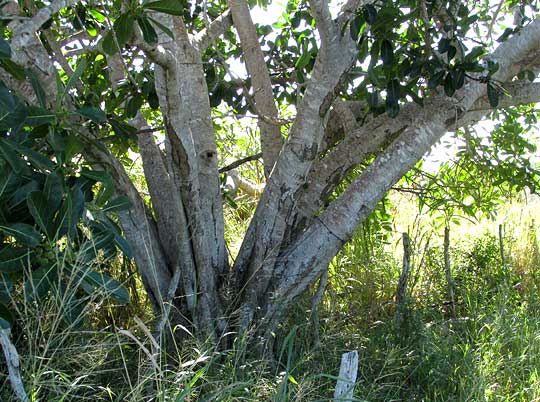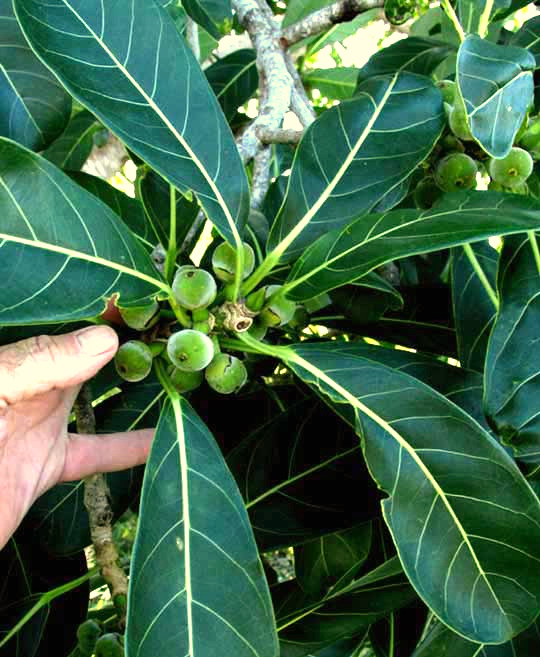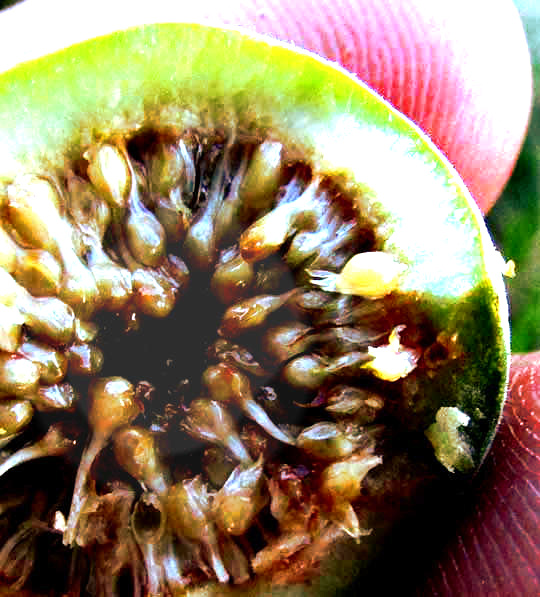Excerpts from Jim Conrad's
Naturalist Newsletter
from the January 11, 2015 Newsletter issued from Río Lagartos, on the Yucatan Peninsula's northern coast (~N21.60°, ~W88.16°), Yucatán state, MÉXICO
STRANGLER FIG
The big strangler fig that had attracted the spider monkeys was probably the most common fig species in these parts. Strangler figs are those who wrap multiple stems around a "host tree," gradually overtopping the host and out-competing it for sunlight and water, until it "strangles" and replaces the host. A young strangler of the same species as our monkey one stands beside the road between Río Lagartos and Las Coloradas. Below, you can see its multiple trunks, which may or may not have formed around a now-vanished host (stranglers don't always need a host tree):

Nowadays this roadside strangler also is producing figs, though they're still hard and green. However, when the figs ripen, bats, birds and other critters will devour them so readily that I'm profiling the tree now before it's stripped of its figs. Below, you can see a branch with its large, green but pale-veined, rounded-tipped, leathery leaves, and some green figs:

A close-up of a twig tip showing a fig subtended by two green, unusually large "basal bracts" -- these are important identification features-- is shown below:

In that picture notice the owl-face twig scar at the lower, left, where the stems of two of last season's figs have fallen off. The fact that two figs were produced there instead of one is a good field mark because many species produce single figs at their stems' fig-making places. The green, teardrop-shaped item at the stem's tip is its terminal bud containing new stem growth that will emerge and grow like crazy when the rainy season returns. Just to confirm that the figs are really figs, below you can see what they look like when they're broken open:

This view reminds us that figs aren't really fruits, but rather structures peculiar to fig species inside which very many flowers are packed together rooted along the structure's interior wall and growing toward its open center. Tiny wasps enter a natural hole in the structure, which is called a "syconium," walk around atop the flowers in the syconium's darkness pollinating the flowers, and then leave, carrying that syconium's pollen to another one. In each syconium three kinds of flowers are found:
All these features lead us to what might be the most commonly encountered wild fig in Mexico and much of tropical America, the strangler fig known as FICUS OBTUSIFOLIA. This species occupies a large variety of habitats, from riversides and mangroves to upland oak forests, from southern Mexico south into Brazil. Obviously it's an adaptable species, and in some places it's aggressive. In parts of Mexico it's considered an invasive species. In Spanish usually it's called Amate or Higuera, but those are names likely to be used for any strangler fig.
If only because many forms of wildlife feed on the species' abundant figs, this is an important tree wherever it occurs. Its a fine shade tree, too. The one in the photo stands at a good turn-around point on my biking road toward Las Coloradas. Each week I spend time enjoying its shade, and watching the figs mature little by little. But I know from experience that because of the competition there always is for ripe figs, I'll be lucky to get any at all.